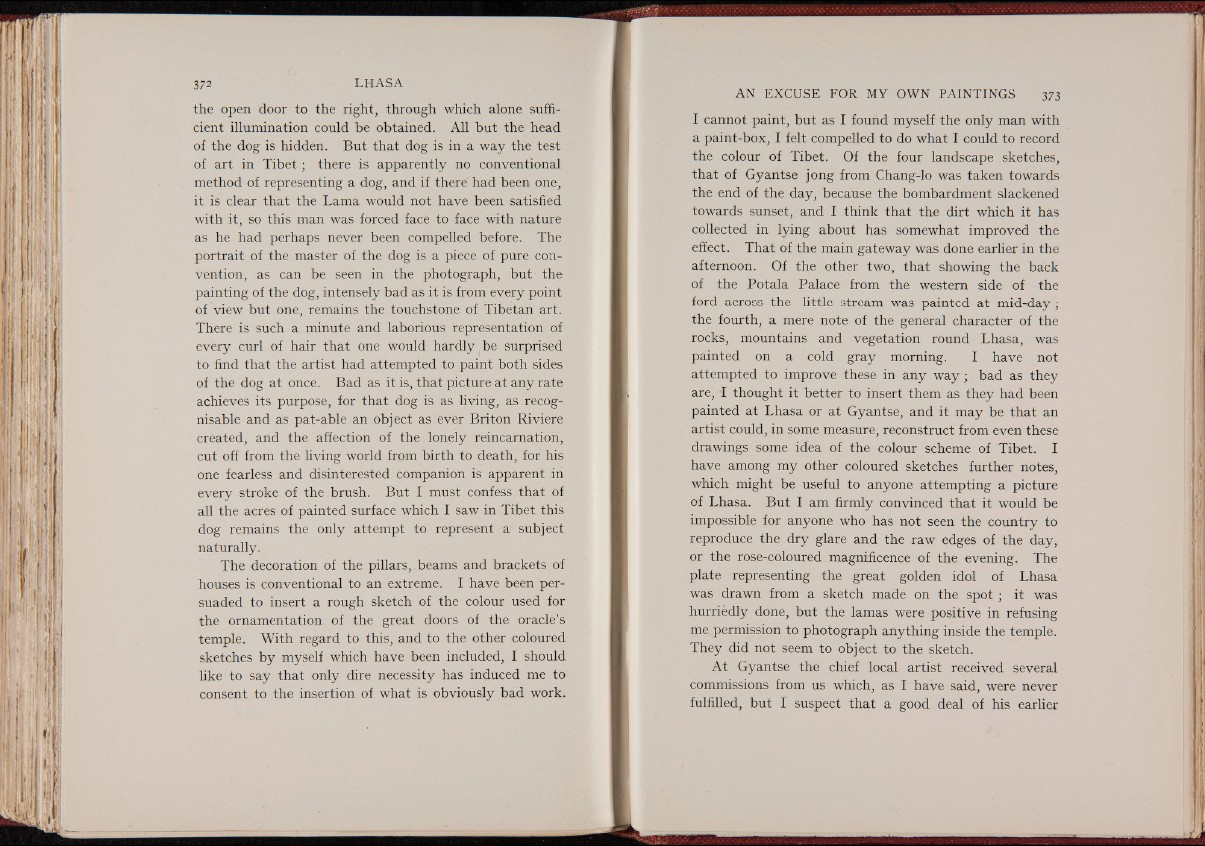
the open door to the right, through which alone sufficient
illumination could be obtained. All but the head
of the dog is hidden. But that dog is in a way the test
of art in T ib e t; there is apparently no conventional
method of representing a dog, and if there' had been one,
it is clear that the Lama would not have been satisfied
with it, so this man was forced face to face with nature
as he had perhaps never been compelled before. The
portrait of the master of the dog is a piece of pure convention,
as can be seen in the photograph, but the
painting of the dog, intensely bad as it is from every point
of view but one, remains the touchstone of Tibetan art.
There is such a minute and laborious representation of
every curl of hair that one would hardly be surprised
to find that the artist had attempted to paint both sides
of the dog at once. Bad as it is, that picture at any rate
achieves its purpose, for that dog is as living, as recognisable
and as pat-able an object as ever Briton Riviere
created, and the affection of the lonely reincarnation,
cut off from the living world from birth to death, for his
one fearless and disinterested companion is apparent in
every stroke of the brush. But I must confess that of
all the acres of painted surface which I saw in Tibet this
dog remains the only attempt to represent a subject
naturally.
The decoration of the pillars, beams and brackets of
houses is conventional to an extreme. I have been persuaded
to insert a rough sketch of the colour used for
the ornamentation of the great doors of the oracle’s
temple. With regard to this, and to the other coloured
sketches by myself which have been included, I should
like to say that only dire necessity has induced me to
consent to the insertion of what is obviously bad work.
I cannot paint, but as I found myself the only man with
a paint-box, I felt compelled to do what I could to record
the colour of Tibet. Of the four landscape sketches,
that of Gyantse jong from Chang-lo was taken towards
the end of the day, because the bombardment slackened
towards sunset, and I think that the dirt which it has
collected in lying about has somewhat improved the
effect. That of the main gateway was done earlier in the
afternoon. Of the other two, that showing the back
of the Potala Palace from the western side of the
ford across the little stream was painted at mid-day;
the fourth, a mere note of the general character of the
rocks, mountains and vegetation round Lhasa, was
painted on a cold gray morning. I have not
attempted to improve these in any way ; bad as they
are, i thought it better to insert them as they had been
painted at Lhasa or at Gyantse, and it may be that an
artist could, in some measure, reconstruct from even these
drawings some idea of the colour scheme of Tibet. I
have among my other coloured sketches further notes,
which might be useful to anyone attempting a picture
of Lhasa. But I am firmly convinced that it would be
impossible for anyone who has not seen the country to
reproduce the dry glare and the raw edges of the day,
or the rose-coloured magnificence of the evening. The
plate representing the great golden idol of Lhasa
was drawn from a sketch made on the sp o t; it was
hurriedly done, but the lamas were positive in refusing
mq. permission to photograph anything inside the temple.
They did not seem to object to the sketch.
At Gyantse the chief local artist received several
commissions from us which, as I have said, were never
fulfilled, but I suspect that a good deal of his earlier